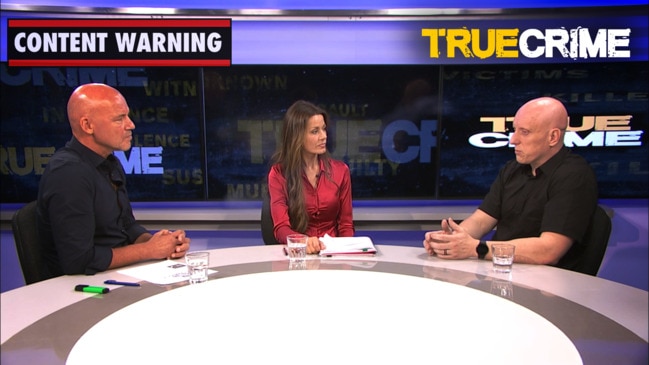How WA sex offender registry works, what Australia can learn from registries worldwide
One Australian state has a sex offender registry. This is how it works and what the nation can learn from other countries which have registries to keep track of paedophiles.

Predatory
Don't miss out on the headlines from Predatory. Followed categories will be added to My News.
It was with trepidation that I sat at my computer to look for convicted child sex offenders near me.
In WA, predators are placed on the Community Protection Offender Register (CPOR), which can been accessed by the public through a government-run website.
The register has three tiers of access, each requiring varying degrees of information.
The first is the Missing Offender Register, which was easily accessible after agreeing to a set of terms.
Within seconds, I was viewing a page with the names and photos of several sex offenders who had breached their reporting obligations — and been labelled “missing”.
The hairs on my neck stood up as I realised these predators were roaming around WA unchecked. Some had been missing for years.
Another click and I could look at a profile for each of the missing paedophiles, with detailed descriptions of their body build, hair and skin colour, as well as scars and tattoos, including some with images, and their last known location.
I was somewhat relieved to know none of them were last reported being in my neighbourhood.
Users are warned not to approach the missing offenders and to contact police if they have seen any of them or have any information about their current whereabouts.
The second level of search is designed to inform residents of people on the database who live in their locality. It requires the applicant to provide some personal details including their WA Driver’s Licence number, before being provided with a unique link.
LISTEN TO THE PREDATORY PODCAST
My link, shockingly, revealed the headshots of three convicted sex offenders in my area. Unlike the first search, there were no further details provided.
As queasy as I felt, I was equally grateful to know what faces to lookout for.
I wished for more information. What did they do? How far away from me were they: one block or one suburb?
The site’s third tier is the Community Protection Disclosure Scheme, which is a more rigorous application for parents or guardians seeking information about people who have regular unsupervised contact with their children, to check if they are on the registry or not.
In WA, convicted child sex offenders are automatically placed on the CPOR and are required to regularly report to police.
There are three classes of reportable offences that can result in someone falling under a reporting order.

Class 1 offences include murdering a child or sexual intercourse with a child. Class 2 includes manslaughter of a child, indecent acts, child pornography, child kidnapping, child exploitation and child prostitution. Class 3 is an offence that does not fall into either of the first two.
Details of the offender recorded on the register include names, address, date of birth, which Class they have been found guilty of or have been charged with and details of the related offences. There’s also information about any protection or supervision orders and date of sentencing and/or release from custody.
The timeframe an offender stays on this register depends on the class of the offence. For example, a single Class 1 offence is 15 years. For Class 1 followed by a Class 1, 2 or 3, they are a reportable offender for life.

HOW SEX OFFENDER REGISTRIES WORK OVERSEAS
The world’s first national-level sex offender registry law was passed by the United States in 1994. In the decades since, similar laws have been enacted by more than 30 countries to register, monitor and track the movements of convicted paedophiles.
Despite the proliferation, the US remains one of the few countries to maintain a nationwide public notification system for the general population to search, in granular detail, where and when child predators move among them.
The US’s system consists of individual public registry websites in each of its 50 states, plus more than 100 Indian Tribes, in the principal US Territories, and the nation’s capital, Washington DC. They are all linked by a national public registry website and notification system.
But apart from localised public registries in states like Western Australia, or the Canadian provinces of Alberta and Manitoba, most of the countrywide sex offender registries that exist in the English-speaking world are only accessible to law enforcement agencies, like Australia’s National Child Offender System (NCOS).
Canada’s National Sex Offender Registry (NSOR) tracks offenders ordered to report annually to the police and provides an instant list of sex offenders who are registered and living within a particular geographic area, but it is not accessible to the public.
New Zealand began its Child Sex Offender Register in 2016. Similar to the United Kingdom, convicted child sex offenders remain on the register for a duration defined by the severity of their crimes and length of sentence.
The public does not have unfettered access to either system, but the UK allows parents to formally apply to check whether an individual in contact with their child is a registered sex offender.
In other Commonwealth nations, a limited degree of public disclosure in certain circumstances is permitted in Bermuda, Guernsey and Jersey, according to the US Department of Justice.
Among the most similar to the US registry are the Maldives and South Korea.
Other countries to have passed, or are in various stages of considering, sex offender registration and notification include Argentina, France, Germany, Ireland, Jamaica, Kenya, Malta, Pitcairn Islands, South Africa, Taiwan, Trinidad & Tobago, and Austria, Bahamas, Fiji, Finland, Hong Kong, Israel, Malaysia, Switzerland, United Arab Emirates, and Zimbabwe.
For more details about the Predatory podcast, go to predatory.com.au
If you have a story to tell, email us at crimeinvestigations@news.com.au
Originally published as How WA sex offender registry works, what Australia can learn from registries worldwide


